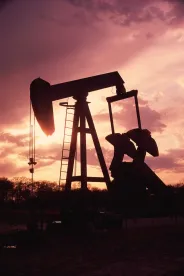At the start of 2015, we look again at some of those issues and what influence they will exert on the Middle East energy sector in 2015 and beyond.
1. Oil Price and the US Shale Oil and Gas Revolution
The latter half of 2014 was dominated by the 40 percent drop in the oil price and the significant impact this has had on oil-producing countries and the global economy. Supply and demand concerns will inevitably dominate the year ahead, but one outcome of the current price slide is a focus on lower cost production regions—including the Middle East—as the supply chain seeks alternative customers for its goods and services as demand stalls in higher cost markets. It will be interesting to see to what extent the lower oil price curbs the US shale oil and gas production boom which US$100 plus oil has permitted over the last five years and which has been the key factor in the recent radical change to the demand/supply dynamics.
2. Volume, Scale and Complexity of Energy Projects
The scale of capital investment in the Middle East makes it a market impossible to ignore, particularly now that the lower oil prices are stalling investment in higher cost areas. Projects valued in excess of US$3 trillion are underway or planned in the region (defined for this purpose as comprising the six Gulf Cooperation Council countries—Saudi Arabia, United Arab Emirates, Kuwait, Oman, Bahrain and Qatar – plus Iraq and Iran). The majority of these relate to upstream oil and gas, downstream (including refineries, LNG and GTL), petrochemicals and related infrastructure projects.
Iraq, Saudi Arabia and Abu Dhabi all have work streams of capital-intensive projects that represent a major draw for EPC contractors and their supply chains.
3. Advanced Technology and Know-how
The Middle East has long been associated with “easy oil” and “low tech, low cost” production models but the petroleum industry is now balancing the politics of “resource nationalism” with the need for international oil companies and their technology. Factors including the rapidly increasing need for enhanced oil recovery (EOR), sour gas, heavy oil, tight gas, LNG, GTL, “clean fuels” refineries, carbon capture and storage, nuclear and solar technologies are driving new requirements for advanced technologies and know-how, much of it garnered by joint ventures with IOCs and their supply chains.
A further drive to advanced technology will follow if the current and prospective Red Sea and East Mediterranean exploration and appraisal programmes bear fruit, as these will bring deepwater fields into play in a region dominated by onshore and shallow water production.
4. Domestic Energy Requirements
Providing energy to fuel domestic economic and population growth remains a key priority for the region with more gas needed to achieve this, particularly in Saudi Arabia, Kuwait and the UAE. This is driving new exploration campaigns, production of unconventional and sour gas and diversification of supply to embrace nuclear and solar energy production.
5. Iraq
Notwithstanding the ongoing security issues in parts of the country, Iraq’s oil and gas industry continues to gather momentum. There will be increasing commercial advantages for, and pressures on, industry players to expand their presence and activities in Iraq.
6. Iran
The oil and gas industry continues to await the rehabilitation of Iran in the international community. The prospective return of Iran to more normalized relations with the USA and the West in general would open up a market that has been starved of technology and capital investment for the best part of a generation. However, should this turn of events ultimately come to pass, it will remain to be seen whether or not Iran persists in a resource nationalism posture or embraces the NOC/IOC partnership approach which has operated so successfully in Qatar and now Abu Dhabi.
7. Cyber Security
Cyber security has become a significant concern for the region’s petroleum industry. The need to manage and contain this risk will be major opportunity for specialist service providers who can contain and defeat these attacks, especially as we move into the era of the digital oilfield.
8. Independent E&P Companies and Frontier/High-risk Opportunities
The activities of NOCs as well as IOCs continue to be complemented by independent exploration and production companies focused on niche or frontier opportunities, often at the high risk/high reward end of the spectrum. This is especially so in Kurdistan in the north of Iraq, where independents are making their mark. But the independents also play a key role in Oman, Yemen and the northern emirates of the UAE. These companies may well serve as a source of future farm-in and even full merger and acquisition activity from the IOCs and/or NOCs when the development capital requirements of the independents, reserve replacement targets of the IOCs and advanced technology and know-how appetites of the NOCs align.
9. Sovereign Wealth and Outward Investment
Finally, the Middle East is home to many of the world’s largest sovereign wealth funds, especially in Abu Dhabi, Kuwait, Saudi Arabia and Qatar. These are now major outward investors with US$2 trillion dollars of combined investments. Abu Dhabi has gone a step further – the emirate’s state-owned TAQA and Mubadala Petroleum are operators of petroleum assets and not simply investors. Mubadala Petroleum is in turn a subsidiary of Mubadala Developments, which is now a leading player in the international renewables industry.
This massive buying and investment power will continue to exert its presence in the international petroleum industry in the years ahead.
10. In-Country Value and Localization
The “Arab Spring” events of 2011 and their aftermath still concentrate the minds of regional governments and this will still feed through to the energy sector in the form of continued focus on in-country value (ICV) – policy requirements on local employment, local content, technology transfer and investment in in-country facilities.



 />i
/>i

